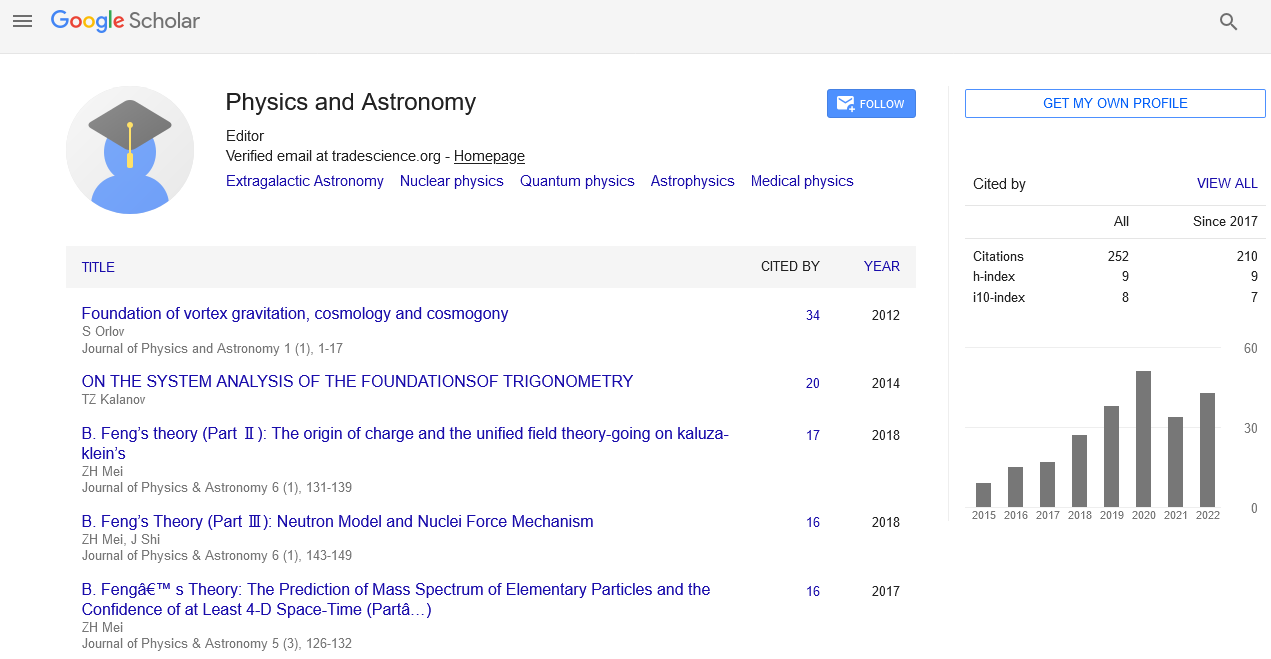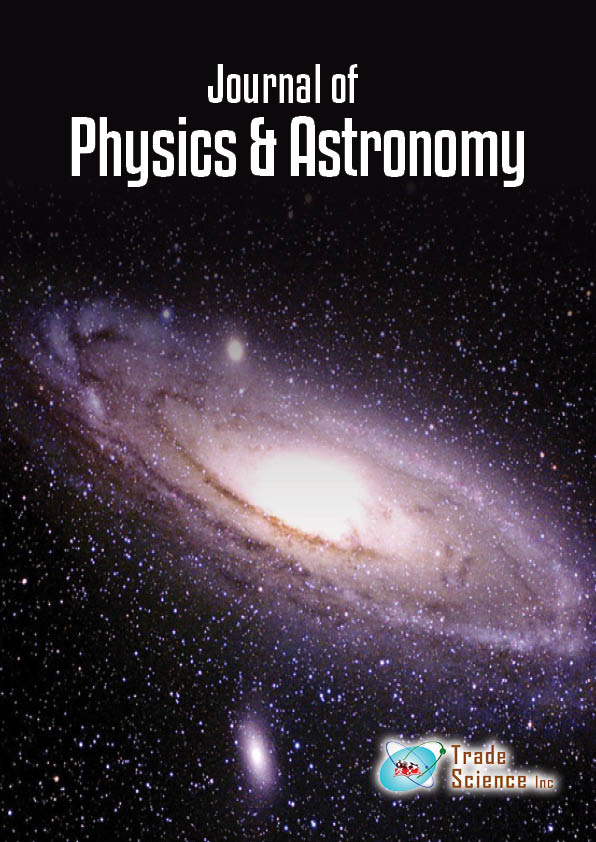Short communication
, Volume: 13( 1) DOI: 10.37532/2320-6756.2025.13(1).402Shrinking Space Interpretation of Universe Expansion
- *Correspondence:
- Zacharias Roupas
Department of Physics, The British University in Egypt, Sherouk City 11837, Cairo, Egypt
E-mail: Zacharias.Roupas@gmail.com
Received: August 21, 2023, Manuscript No. TSPA-23-110888; Editor assigned: August 25, 2023, PreQC No. TSPA-23-110888 (PQ); Reviewed: September 11, 2023, QC No. TSPA-23-110888; Revised: January 09, 2025, Manuscript No. TSPA-23-110888 (R); Published: January 16, 2025, DOI. 10.37532/2320-6756.2025.13(1).402.
Citation: Roupas Z. Shrinking Space Interpretation of Universe Expansion. J Phys Astron. 2025;13(1).402.
Abstract
We argue that cosmological expansion may be interpreted as a decrease of fundamental space space-time scales. Two galaxies at a fixed distance appear drifting apart if the length length-scale by which the observer measures their distance is decreasing. This perspective suggests that space space-time is a derivative concept emerging from more fundamental degrees of freedom and their underlying, as of yet, unknown processes.
Keywords
Shrinking space; Cosmology; Degrees of freedom
Introduction
The current, main paradigm for cosmology suggests that the universe is expanding. Space is being stretched and material within this space is supposed to be drifted along, which explains the observed accelerated increase of distance between galaxies [1,2]. The size of the universe however is not determined with respect to external quantities, but with respect to its internal context. Therefore, the observed increase of galaxies’ distance implies that implicit properties of the universe itself are evolving. In the next section we shall propose that these evolving implicit properties of the universe are the fundamental length and time scales. This evolution is equivalent to an expanding universe. In the last section we further discuss our inspection.
Shrinking space
We shall show that the static de Sitter space is equivalent to a dark energy universe undergoing exponential expansion. The coordinate transformation that relates the two space times allows us to interpret the expanding space in the dark energy universe as a shrinking space in the equivalent static de Sitter description.
Let us write the static de Sitter metric in the spherical coordinates (R, T)

where r;H is a constant, with units of length, equal to the cosmological horizon radius. Consider the coordinate transformation (R, T) ↔ (r, t), suggested by Lemaitre [3] and Robertson [4],

and equivalently

For an, as yet, undetermined function a(t). The significance of this transformation in transforming an expanding FLRW universe to a static de-Sitter space was emphasized by Tolman (Figure 1) [5].
FIG. 1. Both panels describe the same universe in two different, equivalent perspectives. The left panel corresponds to the LRT-coordinates and the right panel to the FLRW-coordinates. In both pictures ? denotes the length scale and R the distance between galaxies. Time is increasing downwards, so that the same row denotes the same instant of time in the two panels. In the left panel, depicting the “Shrinking Space”, the distance Ris constant and the length scale r is decreasing, equation. In the right panel, depicting the “Expanding Space”, the distance R is increasing and the scale r is constant, equation. In both cases the ratio R/r is the same at each instant of time.
Here the transformations (2)-(3) or (4)-(5), the LRT-tranformation (Lemaitre, Robertson, Tolman), and the coordinate system (R, T), the LRT-coordinates. We find that for

the metric (1) becomes

This is exactly the FLRW solution for a spatially flat dark energy universe. It gives

where H is the Hubble constant. The curvature RdS of de-Sitter space (1) is straightforward calculated to equal

This is identical with the FLRW curvature, provided (6) holds

Given the transformation (2), (3), (6), the topology of the spaces (1) and (7) is identical. The LRT-transformation (4)-(5) modifies the dynamic FLRW metric (7) to a static solution and vice versa. In the FLRW-coordinates, the quantity R, Equation. (4), is interpreted as the ever growing distance between objects with respect to ?, due to the increasing scale factor a(t), for a constant length scale r.
Let us interpret the LRT-coordinates. Since in these coordinates, as in equation (1), R is constant, how is it possible for the space to be expanding? If in equation r(T, R) = R/a(t(T, R)) one considers that R – the distance between objects in the FLRW-space - is constant, then it is the quantity r that it is changing with respect to time T perceived by an LRT-observer. It is decreasing as

Description
In the LRT-coordinates the space is shrinking approaching finer and finer scales, like the unit of length-scale getting smaller and smaller. This is experienced as growing distance between objects and is depicted in Figure 1. We shall discuss further the meaning of approaching finer and finer scales in the next section. All of the above were meant to demonstrate the shift of perception from an expanding space to a shrinking space. The equivalent metrics (1), (6)-(7) are believed to be good approximation of the initial moments of our universe, namely the early inflation era, when the universe is assumed to be undergoing (nearly exact) exponential expansion. When matter, dark or luminous, is considered then ??=??(??) ≠ const. and the metric (7) is no longer isomorphic to a static metric, even in the dark energy dominated era. The transformations (2), (3), will leave time-dependent components in the metric. Nevertheless, the transformation (2) may still be interpreted as a length-scale time dependence implying shrinking of space. It is just that, now time may also be affected and also that the effect of the length-rescaling on matter has to be taken into account and calculated. In fact, Wetterich [6] has already performed a similar task. He discovered a model in which the universe expansion, at all stages, arises exactly because of the time evolution of fundamental length and mass scales, that is perceived as shrinking of matter. Finally, we remark that the conformal time η.

transforms the FLRW metric, spatially flat or not,

to a conformally static metric

for any α(t). The scale factor is transformed to a conformal factor. This hints that cosmological expansion is also related to a shrinking of fundamental time intervals given b 12).
The shift in perspective proposed in this work is directly analogous to shifting from a geocentric to a heliocentric perspective. In both cases there is a change of coordinate systems involved. A galaxy-based coordinate system suggests the expanding space perspective. However, in the equivalent coordinate system (1) in which space is static, it seems as though galaxies are still, their in-between space appearing to increase because of a decrease of the fundamental length-scale.
One may wonder what does it mean for the length-scale to decrease or as we mentioned for matter to probe finer and finer scales. This question and the shift of perspective we propose does not only have philosophical implications, but also practical consequences as well pointing towards certain type of physical theories. In particular, a “cosmological black hole”, which describes the interior of an astrophysical black hole as a static dark energy universe (de Sitter) [7,8] with a common dual cosmological-black hole event horizon fits excellently to the shrinking space scenario. The quantity ??H in (1) is then identified both with the cosmological horizon radius and the black hole horizon radius

where ρΛ is the dark energy density, M• the corresponding black hole mass and H the Hubble constant. In this case, the static coordinate system (1) corresponds to a dark energy universe that is perceived as a black hole by an observer in another universe which hosts the descendant universe, namely the, so called, cosmological black hole predicted in [7,8]. The shrinking space interpretation fits also well to earlier ideas of a universe hosted inside a black hole [9–13], even though in these cases the black hole and cosmological horizons do not coincide. In addition, the shrinking space interpretation applies well to holographic universe scenarios [14–16]. In all of the aforementioned cases, the universe is supposed to be contained in some form of a static screen, being either a cosmological holographic screen or an event horizon. Space and time may emerge from information processing, in a similar manner that the volume of a black hole grows while the horizon area is constant [17] or entanglement entropy and holographic complexity grow on a horizon [18–20].
Conclusion
Cosmological expansion is in our view a manifestation of some information processes of underlying degrees of freedom. For example, growing of complexity of the fundamental degrees of freedom can cause the derivative, emergent degrees of freedom like space and time, to alter their perceived size if complexity in the fundamental reality describes the amount of available state configurations in the emergent reality. In other words, some information processes (e.g. growth of complexity) in the fundamental reality generates more room for action in the derivative, emergent reality, as perceived by the emergent universe inhabitans. In this sense universe expansion corresponds to a shrinking spacetime.
References
- Riess AG, Filippenko AV, Challis P, et al. Observational evidence from supernovae for an accelerating universe and a cosmological constant. Astron J. 1998;116(3):1009.
- Perlmutter S, Aldering G, Goldhaber G, et al. Measurements of Ω and Λ from 42 high-redshift supernovae. Astron J. 1999;517(2):565.
- Lemaitre G. Note on de Sitter's universe. J Math Phys. 1925;4(1-4):188-92.
- Robertson HP. LXXXVI. On relativistic cosmology. London Edinburgh Dublin Philos Mag J Sci. 1928 May 1;5(31):835-848.
- Tolman RC. Relativity, thermodynamics, and cosmology. Courier Corporation; 1987.
- Wetterich C. Universe without expansion. Phys Dark Universe. 2013;2(4):184-187.
- Roupas Z. Detectable universes inside regular black holes. Eur Phys J C. 2022;82(3):255.
- Pathria RK. The universe as a black hole. Nature. 1972;240(5379):298-299.
- Frolov VP, Markov MA, Mukhanov VF. Through a black hole into a new universe?. Phys Lett B. 1989;216(3-4):272-276.
- Frolov VP, Markov MA, Mukhanov VF. Black holes as possible sources of closed and semiclosed worlds. Phys Rev D. 1990;41(2):383.
[Crossref] [Google Scholar] [PubMed]
- Susskind L. The world as a hologram. J Math Phys. 1995;36(11):6377-6396.
- Smolin L. The life of the cosmos. Oxford University Press, USA; 1997.
- Afshordi N, Corianò C, Delle Rose L, et al. From Planck data to Planck era: observational tests of holographic cosmology. Phys Rev Lett. 2017;118(4):041301.
[Crossref] [Google Scholar] [PubMed]
- Christodoulou M, Rovelli C. How big is a black hole?. Phys Rev D. 2015;91(6):064046.
- Calabrese P, Cardy J. Evolution of entanglement entropy in one-dimensional systems. J Stat Mech Theor Exp. 2005;2005(04): P04010.
- Hartman T, Maldacena J. Time evolution of entanglement entropy from black hole interiors. Int J High Energy Phys. 2013;2013(5):1-28.
- Stanford D, Susskind L. Complexity and shock wave geometries. Phys Rev D. 2014;90(12):126007.
- Susskind L, Zhao Y. Switchbacks and the Bridge to Nowhere. arXiv preprint arXiv:1408.2823. 2014.
- Roberts DA, Stanford D, Susskind L. Localized shocks. J High Energy Phys. 2015;2015(3):1-27.
- Caginalp RJ. Holographic complexity in FRW spacetimes. Phys Rev D. 2020;101(6):066027.


